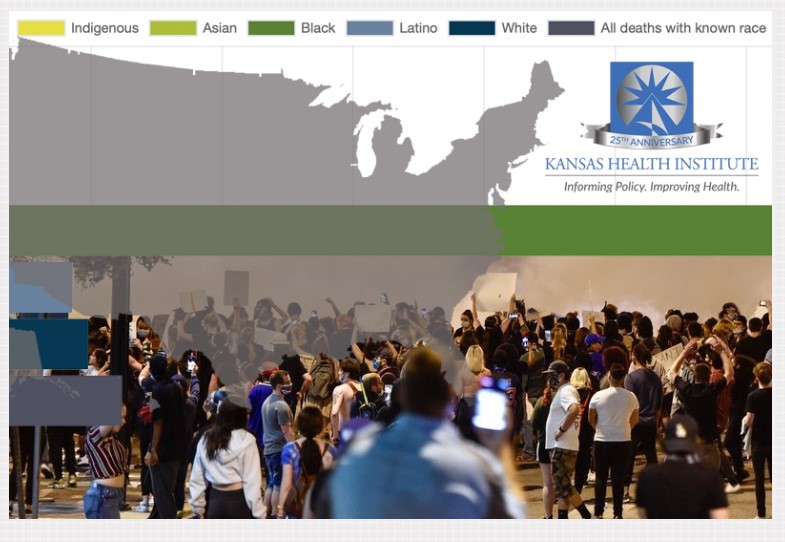It will be difficult to examine and discuss the litany of statistics demonstrating large racial and ethnic disparities in health outcomes in our country and in our state in the same light following the recent, shocking deaths of George Floyd and other black Americans across many of our communities. It will be even more difficult to develop and implement meaningful policies addressing the entrenched social and economic conditions, including systemic racism, underlying these shameful statistics.
As an organization committed to nonpartisan research, education and engagement, we struggle with the adequacy of our work to effect change on this scale. The harshness of one video of the death of a black man under the knee of a police officer has had more impact than all of the past, and likely all of the future, reports documenting the diminished health and early death of people of color. These impressive findings have covered the gamut of disparities including in health care, education, employment, child welfare, housing, transportation, and environmental conditions.
As the public health, health policy and political worlds grapple with their respective roles in understanding and addressing racism, KHI will be actively listening to identify our appropriate role. While data-driven and evidence-based information will remain our focus, we will engage new voices and place increased credibility and value on lived experience alongside statistical significance. As an organization deeply opposed to racism in all of its forms, we will seek a role supporting those in our state who are committed to addressing disparities in health and the underlying societal conditions that we know exist. That is the essence of our vision as an organization — healthier Kansans through effective policy.
At the same time these challenges take center stage, we are in the midst of the worst global pandemic in over a century that is wreaking havoc on our public health and health care systems as well as on our economy. The impact being borne disproportionately by people of color only adds to the sense of urgency. National data show that the death rate among Black Americans is 2.4 times higher than among Whites (54.6 deaths per 100,000 compared to 22.4 deaths per 100,000).
Distressingly, national data show that Kansas ranks 42 out of 43 states in a recent analysis of disparities in deaths for people of color. The latest figures available from the Kansas Department of Health and Environment (KDHE) show that one out of every four (25.9 percent) deaths from COVID-19 in our state has been among Kansans who are Black or African American, despite the fact that this group represents only one out of every 17 (6.0 percent) people in our state. KDHE data also show that the rate of COVID-19 cases among Hispanic/Latino persons in Kansas is 12.92 (per 100,00 persons), more than eight times the rate of 1.61 (per 100,00 persons) among those who are not Hispanic/Latino.
The non-health related impacts of COVID-19 have also been felt disproportionately among people of color. Job losses related to the economic collapse have exacerbated longstanding disparities in employment. The latest numbers from the federal government show that the unemployment rate has soared among Black/African Americans to 16.8 percent and among Hispanics to 17.6 percent, both even higher than the 12.4 percent among Whites (May’s labor report). Statistics examining these trends in Kansas have not been available but are likely to be similar.
One predictable result of these trends in employment is the widening of the gaps in insurance coverage for people of color. Employment is how most Kansans get their health insurance and as jobs are lost, the risk of being uninsured increases. In the next few days, KHI will be releasing its annual report on insurance coverage in Kansas. The data are from well before the pandemic struck, and show that the uninsured rate among working age adults (age 19-64) in Kansas was 2.2 times higher among people of color than for non-Hispanic Whites, (21.0 percent compared to 9.5 percent). The disparity persists even among children in our state, challenging our claims that all children are given the same opportunity to succeed. Children who belong to a racial/ethnic minority are 1.9 times more likely than non-Hispanic White children to be uninsured (7.8 percent compared to 4.2 percent).
These are but a few of the endless numbers that speak to the racial and ethnic disparities in Kansas. If you are interested in learning more, consider looking at our 2017 report entitled Racial and Ethnic Disparities in a Changing Kansas containing more than 700 pages of data.
But we have been reminded recently that alone, all of the data in the world is not enough to make necessary or desired change. During my time in a leadership role at KHI, we will humbly join our many partners in the difficult work ahead to create meaningful, lasting change that addresses longstanding disparities impacting our fellow Kansans.
Bob St. Peter
President and CEO
June 8, 2020
